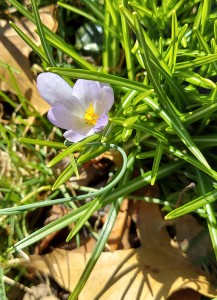 I am an inveterate walker and when I hit the pavement I am on the lookout for lovely gardens, interesting plants, and trees engaged in the daily miracles that make them essential to the planet’s existence. Right now everything is about to rev into high gear as spring looms ahead. You can almost hear the hum as the smaller bulb plants bloom, trees start to leaf out, and even the more cautious plants, like tulips, decide that it is safe to start the journey to flowering.
I am an inveterate walker and when I hit the pavement I am on the lookout for lovely gardens, interesting plants, and trees engaged in the daily miracles that make them essential to the planet’s existence. Right now everything is about to rev into high gear as spring looms ahead. You can almost hear the hum as the smaller bulb plants bloom, trees start to leaf out, and even the more cautious plants, like tulips, decide that it is safe to start the journey to flowering.
When I am out walking, I often notice crocuses in unlikely places—singletons coming up in the middle of lawns, small clumps in untended corners of public parks and scattered groups by the little streams that run through the suburbs where I live. Some of those random crocuses are the Dutch giant variety; others appear to be the prolific “tommie” crocus or Crocus tommasianus. A few might be little snow crocuses. Sometimes I also see snowdrop singletons, though that is much rarer, because snowdrops are less universally popular than the various crocuses.
Seeing the little flowers growing at random makes me wonder how they arrived at their unlikely locations. Clusters of crocuses growing in lawn areas close to driveways or walkways might be the remnants of long untended garden beds planted by previous homeowners. Neighborhood associations or horticulturally-minded individuals sometimes plant bulbs along streams as a public service. Over time, if Nature doesn’t interfere too violently and humans ignore the spots, the original small clumps spread, creating colorful spring swathes along those streams.
But what about the random crocuses and occasional snowdrops that pop up on the edges of public parks, or railroad rights-of-way, or other completely untended spaces?
I think the answer is squirrel landscaping.
The common gray squirrel, or Sciurus carolinensis, is omnipresent, omnivorous, and omni-annoying to gardeners. While cute in appearance with their fluffy tails and bright eyes, they dig where they should not, uprooting bulbs planted purposely, and “planting” other items, like acorns and chestnuts, which need to be grubbed out later on.
To be fair, gray squirrels also play an important role in forest regeneration, with their prolific and indiscriminate planting habits. For that reason, I try to think kindly of them.
I am quite sure that squirrel landscaping has kept my stand of tommie crocuses on the move for years. A decade or more ago, I planted about fifty of them in a bed in my lower back garden. The following spring, most of them sprouted there. At least ten, however, had moved to the adjacent path, and one had jumped to the other side of the yard. Since crocuses do not have wings, I suspected squirrels.
That spring I gamely dug up all the squirrel-planted bulbs and put them back in their original places. I scattered large amounts of onion grass over the newly replanted area in the hopes that the squirrels would shy away from the strong smell.
I was wrong, and, in fact, my efforts seemed to energize the rodent landscapers. The following spring, even more crocuses had migrated. I am a persistent gardener, but I am not nearly as persistent as a species that has been landscaping in this way for centuries, if not millennia. I gave up. If the squirrel-planted crocuses are not in a place where they were likely to be stepped on, I let them go. Tommies are not quite as prolific as gray squirrels, but they do reproduce handily. Squirrel landscaping has now provided me with clumps throughout the yard. I am grudgingly grateful.
I am also a bit thankful for the squirrel who planted a single snowdrop in an out-of-the-way spot in a nearby public park. Eventually that snowdrop will also reproduce and, after awhile, make its own joyful spring clump.
Of course, you can try to “squirrel proof” bulbs by spraying them with repellent, or corralling them into wire mesh cages before you plant them. The cages are probably more effective, but do require some additional expense and effort.
From a walker’s standpoint, squirrel landscaping adds interest. From a gardener’s standpoint it can add either frustration or serendipity, depending on the number and ingenuity of the  squirrels, the Type A tendencies of the gardener and the resilient nature of the bulbs themselves. The squirrels won’t change, so it is up to you.
squirrels, the Type A tendencies of the gardener and the resilient nature of the bulbs themselves. The squirrels won’t change, so it is up to you.
